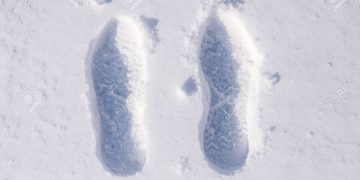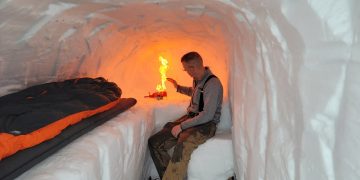Human footprints have long been a subject of fascination and mystery, particularly when it comes to tracking them in the wild. Whether it’s for scientific research, criminal investigations, or simply for outdoor exploration, the ability to follow these subtle signs can reveal a great deal about human behavior, movements, and the environments they inhabit. But is it truly possible to track human footprints in the wild, and if so, how can it be done effectively?
In this article, we explore the art and science of tracking human footprints, diving into the methods used, the challenges faced, and the skills required to successfully follow these often fleeting imprints in the wilderness.
The Science Behind Human Footprints
A footprint is the impression left by a foot pressing into the ground. When humans walk, their weight distributes unevenly on the surface beneath them, leaving a print. These prints are not just shaped by the physical structure of the foot but also influenced by the terrain, the weather, and the conditions of the ground. The study of footprints, or pedology, is an interdisciplinary field that merges forensics, anthropology, and environmental science.
When tracking human footprints in the wild, experts consider several factors:
- Footwear – The design of shoes or boots can significantly affect the print. For example, hiking boots leave deep, ridged impressions, whereas flip-flops may leave very shallow, soft marks.
- Gait – The way a person walks, whether it’s a heavy stride or light steps, can leave clues in the depth, shape, and size of the print.
- Ground Conditions – Wet soil, sand, snow, or muddy ground all leave different kinds of prints. Wet ground may preserve more detail, while dry, rocky terrain may leave little to no trace.
- Age of the Print – Footprints can change over time. In some cases, they may get washed away by rain, eroded by wind, or blurred by the passage of time, making it harder to track someone over long distances.
By studying these elements, trained trackers can determine not only the size of the person’s feet but also their gait, speed, and even the direction they were moving.
The Art of Tracking: Techniques and Tools
While it may sound like something from an adventure novel or crime thriller, tracking human footprints in the wild is an intricate skill. It requires knowledge of human anatomy, environmental awareness, and patience. Many trackers use a variety of methods to follow footprints across challenging landscapes.
- Initial Identification
The first step in tracking is identifying the print itself. Experienced trackers can discern a human footprint from animal tracks based on shape, size, and certain distinct features. Human prints tend to be more detailed and have a consistent shape due to our unique foot structure, which is relatively different from the paws of animals.

In areas where wildlife is abundant, it’s crucial to distinguish between human prints and those of predators or prey. For example, the print of a wolf or large cat like a mountain lion can sometimes resemble that of a human, though the key differences are typically visible when examined closely.
- Following the Trail
Once the footprint is confirmed as human, trackers begin following the trail. Depending on the environment, this can range from easy to extremely difficult. In forests, for example, the ground may be soft enough to hold a print, but the foliage can obscure the path. In deserts, footprints might be harder to see due to the hard, dry ground.
To make things easier, trackers often use tools like a track stick, which is a long, thin rod used to probe the ground and highlight footprints. In some cases, dusting the trail with flour or chalk can make footprints more visible in certain environments, though this method is not always practical.
- Reading the Print
Experienced trackers don’t just look at the print itself—they analyze the surrounding terrain as well. The depth of the print can give clues about the person’s weight and the type of ground they walked on. The spacing between prints can indicate the person’s speed or whether they were running or walking.
By carefully measuring the prints’ depth, size, and spacing, skilled trackers can infer a lot about the individual’s movements. For instance, closely spaced prints may indicate a slow, deliberate walk, while wide-spaced prints suggest someone who is either walking briskly or running.
- Environmental Considerations
One of the most critical aspects of tracking is understanding the environment. Different landscapes can either preserve or degrade footprints. Mudflats and wetlands, for example, can preserve footprints with remarkable detail for extended periods of time. On the other hand, rocky terrain and sand dunes may erase traces almost as soon as they are made.
Another environmental consideration is weather. Rain, snow, or even wind can significantly affect the clarity of a footprint. In the case of snow, tracks may remain visible for days, but in heavy rain, footprints can be washed away in minutes.
Challenges in Tracking Human Footprints
Despite the fascinating science behind it, tracking human footprints in the wild is far from easy. Several factors complicate the process, making it both a challenging and a highly specialized skill.
- Degradation of Footprints
Footprints are inherently ephemeral. Even if a footprint is clear and visible in the moment, it can degrade quickly due to environmental factors. Heavy rainfall, wind erosion, and even animal activity can obscure or erase footprints within hours or days. In some cases, footprints might be so faint or distorted that even an experienced tracker can have difficulty interpreting them.
- Multiple People and Disturbances
In areas where multiple people walk, following a single individual becomes challenging. The prints of several individuals walking along the same path can overlap, blur, or create confusion, especially if different types of footwear are involved. Additionally, if there are animals, vehicles, or wind disturbances, these can further complicate the process, masking or destroying tracks altogether.

- Difficult Terrain
Certain terrains, such as dense forests, rocky hills, or thick underbrush, may make it difficult to identify or follow footprints. In these areas, the lack of continuous ground cover may leave only scattered prints, which can be hard to piece together into a coherent trail. Tracking is often slower, and the trail may be lost altogether if the tracker does not remain focused.
- Human Factors: The Tracker’s Skills
Not all human trackers are equally skilled. Experience is crucial, as is knowledge of the environment being tracked. A skilled tracker knows how to read the subtle differences in terrain and understand the nuances of the environment. It’s not just about finding the print—it’s about interpreting it accurately. This requires extensive knowledge of human movement and a deep understanding of the natural world.
Tracking Footprints in Different Environments
The environment in which footprints are being tracked can greatly influence the difficulty and success of the process. Let’s look at how human footprints behave in different natural settings.
- Deserts
Desert landscapes, with their dry sand and hard earth, pose significant challenges for tracking. Sand, while capable of preserving footprints, can also easily erase them with a gust of wind. However, soft patches of dirt or areas with dew can leave behind clearer, more defined prints. In the desert, trackers need to act quickly to find and follow prints before wind or foot traffic erases them.
- Forests and Woodlands
Forests offer a mixed bag for trackers. While the soft, moist soil can preserve footprints well, the thick underbrush and fallen leaves can obscure them. However, with the right training, a skilled tracker can use the density of the forest to their advantage, finding prints in less disturbed patches of ground or following disturbed vegetation along the path.
- Snow and Ice
In snowy environments, footprints can last for a long time, allowing trackers to follow a trail for days. The sharp contrast between snow and the human print makes it relatively easy to spot, but snow can also be deceptive. Melting, wind, and shifting snow can distort or obscure tracks, meaning that trackers need to pay close attention to the subtleties of the print’s depth and shape.
- Mountains and Rocky Terrain
Tracking on rocky terrain is one of the most difficult environments for footprint tracking. Rocks and hard surfaces don’t retain prints well, and the terrain often has uneven surfaces that obscure clear impressions. In mountainous regions, the slope of the ground can make following tracks a physically challenging endeavor as well.
Conclusion: The Skill of Tracking Human Footprints
Tracking human footprints in the wild is a challenging, but fascinating, skill. Whether for survival, exploration, or criminal investigation, the ability to follow these traces provides valuable insight into human movement, behavior, and interaction with nature. It requires a deep understanding of human anatomy, a keen eye for detail, and a profound knowledge of the environment.
While it may not be as simple as it appears in movies or TV shows, skilled trackers—be they scientists, law enforcement officers, or wilderness experts—can unravel the story told by footprints and use this information for a variety of purposes. With practice and patience, even the faintest trace in the wilderness can become the key to unraveling a mystery, understanding human activity, or simply exploring the natural world.























